Facilities tours
Displays (RIKEN campus)
Information on displays on RIKEN's campus.
RIKEN Gallery
*Please understand that we do not take requests for individual tours by persons not affiliated with RIKEN.
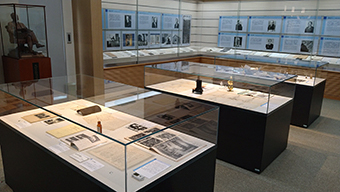
This room has information on RIKEN's history, research summaries, research outcomes, and more. Once a year on Wako Open Campus Day, RIKEN Gallery is open to visitors to freely enjoy.
Location: RIKEN Gallery 1F, 2-1 Hirosawa, Wako-shi, Saitama
Entrance fee: Free
Open: Weekdays from 10:30 am to 4:00 pm
- * Please note that RIKEN Gallery will be closed on RIKEN Foundation Day (the 4th Monday of October) and for year-end and new year's holidays.
Inquiries:
Email: event-koho@riken.jp
Reserved tours of SPring-8 / SACLA
Tours of the large synchrotron radiation facility, SPring-8, and the X-ray Free Electron Laser facility, SACLA, are available.
Location: 1-1-1 Kouto, Saya-cho, Sayo-gun, Hyogo
Eligibility: Groups of 15 or more
Tour time: 9:30 am to 3:30 pm
Tour period: Every day excluding weekends, holidays, the Obon season, and the year-end/new year period between December 29 and January 3.
See the RIKEN SPring-8 Center webpage for details about tours.
Tour of the supercomputer Fugaku and the exhibition area
Fugaku was completed and shared-use began in March 2021. Tours for groups only (advance reservation required) of Fugaku and of the Fugaku exhibit area (no reservation required) are available.
Along with having a video corner where one can learn about the supercomputer or research outcomes, the exhibit area has panels that explain Fugaku, which is currently in use, and calculation racks and system boards from the supercomputer "K" which ceased operations in August 2019. Please understand that Fugaku cannot be seen from the exhibit area.
Location: 7-1-26 Minami-machi, Minato-jima, Chuo-ku, Kobe City, Hyogo
Please see the link for details on Fugaku tours.
Exhibits (off RIKEN campus)
Information on displays that are not on RIKEN campuses.
Tokyo Skytree®
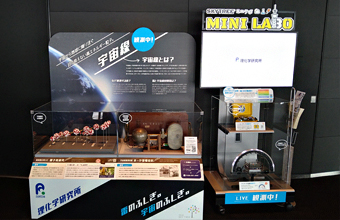
RIKEN was using the height of Tokyo Skytree® to observe the gamma radiation that occurs from lightning. Items such as "Kogamo," a gamma-ray detector, and other research results that have come out of RIKEN are displayed at Tokyo Skytree®'s observation deck, SKYTREE® MINILABO.
Location: SKYTREE® MINILABO, floor 345, Tokyo Skytree Observation Deck
How to get there: Tokyo Skytree Station on the Tobu Skytree Line or Oshiage (Skytree-mae) Station on the Tokyo Metro Hanzomon Line
Please check the Tokyo Skytree® website for information on hours and entrance fees.
Exhibits
Cosmic ray observation equipment and its history
In 1936, RIKEN imported Japan's first cosmic ray observation equipment, the Neher Electrometer. Due to its portability, it was used in scientific surveys of the atomic bomb conducted by RIKEN in 1945. In Hiroshima it was used to measure the distribution of radiation from the epicenter; in Nagasaki it contributed to fixing the epicenter by correcting deviations in the epicenter estimates made by shadows from the atomic bombing.
The gamma-ray detector "Kogamo" measures gamma rays from thunderclouds and space, which are collected as research data. A cosmic ray monitor known as "Ame-agari" which uses LEDs to visually represent the direction and intensity of gamma rays is also on display. Cosmic rays collide with atmospheric molecules to create high-energy particles. By using "Ame-agari," we can observe from which direction high-energy particles will fall.
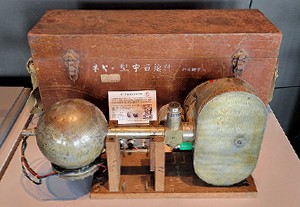 Neher Electrometer, cosmic ray
Neher Electrometer, cosmic rayobservation equipment
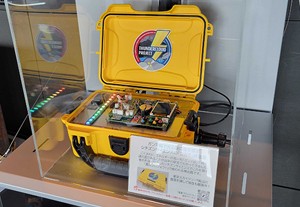 Kogamo, gamma-ray detector
Kogamo, gamma-ray detector
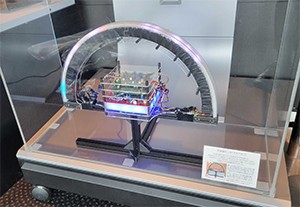 Ame-agari, cosmic ray monitor
Ame-agari, cosmic ray monitor
Explanation of RIKEN's nuclear physics
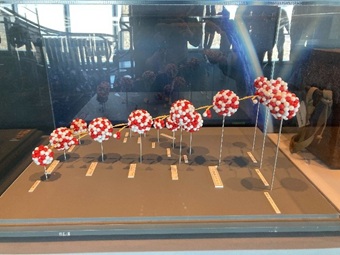 The synthesis and fission processes of Nihonium, the 113th element which was discovered by RIKEN
The synthesis and fission processes of Nihonium, the 113th element which was discovered by RIKEN
Cosmic ray research at RIKEN began in the lab of nuclear physicist, Dr. Yoshio Nishina (1890 - 1951). As an introduction to nuclear research using accelerators, which are like "brothers" to cosmic ray research, an atomic nucleus model is on display which shows the synthesis and fission processes of Nihonium, the 113th element which was discovered by RIKEN and the first element discovered in Asia.
Optopia
There are casts of SPring-8 and SACLA on display at the Harima Science Garden City PR Building, "Optopia."
Location: Koto Plaza 1 F, 2chome-23-1 Koto, Kamigori, Ako District, Hyogo Prefecture
Hours: 10:00 am - 4:30 pm
Closed: Mondays and from December 29 to January 3
Entrance fee: Free
Exhibit cooperation
Bando Kobe Science Museum
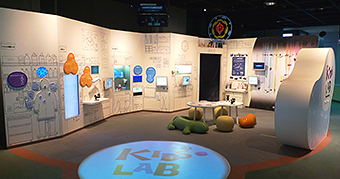
"Bio-Kids Lab: The mysteries of genesis and regeneration"
Visitors can learn about the wonders of development, in which a body is created from a single fertilized egg, and about stem cells, which are expected to be used in regenerative medicine, through hands-on experience. There are also exhibits on Dr. Osamu Shimomura who was awarded the Nobel Prize in Chemistry in 2008 for green fluorescent proteins (GFP) and on chicken and turle embryos.
Location: Shinkan 3FL Exhibition Room 5, 7-7-6 Minato-jima, Naka-machi, Chuo-ku, Kobe, Hyogo
*Please visit the Bando Kobe Science Museum website for details on hours and fees.
Miraikan - The National Museum of Emerging Science and Innovation
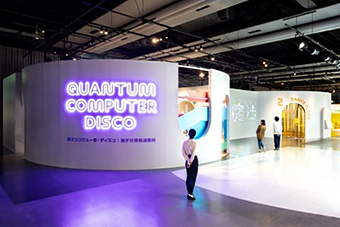 Photo courtesy of Miraikan
Photo courtesy of Miraikan
"Quantum Computer Disco"
Quantum computers have the potential to revolutionize countless fields of science. At “Quantum Computer Disco,” visitors can visualize how quantum computers perform calculations by acting as DJ, choosing their favorite music and playing it on the dance floor. In addition to the basic principles and mechanisms of quantum computers, with the help of easy-to-understand explanations, visitors can learn about the evolution of computers -from analog computers to quantum computers. On display is a qubit chip of the same type used to control the calculations of the superconducting quantum computer developed by the RIKEN Center for Quantum Computing.
Location: Miraikan 3F, Permanent Exhibition Zone, 2-3-6 Aomi, Koto-ku, Tokyo
* For details such as opening days and hours, admission fees, etc., please check Miraikan’s official website.
